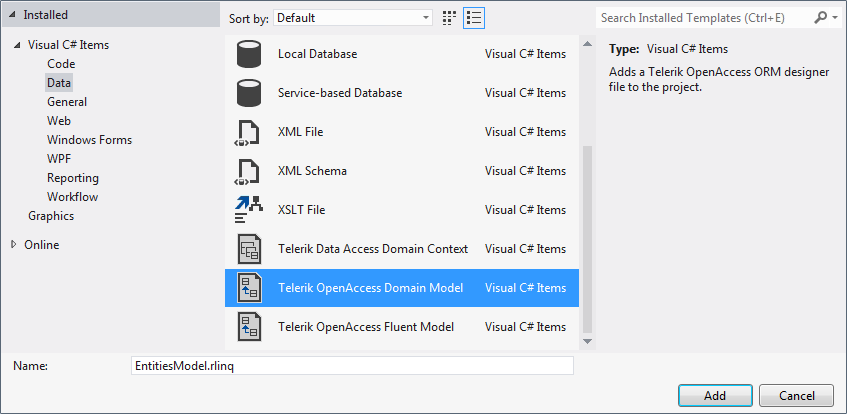Create Model Wizard - Overview
This article is relevant to entity models that utilize the deprecated Visual Studio integration of Telerik Data Access. The current documentation of the Data Access framework is available here.
The Telerik Data Access Create Model Wizard is used to generate a domain model from an existing database or an empty one. The Telerik Data Access Create Model Wizard starts after you use any of the following templates:

- Telerik Data Access Class Library - adds a new project and runs the Telerik Data Access Create Model Wizard. The output of this template is a new domain model (.RLINQ file).
- Telerik Data Access Fluent Library - adds a new project and runs the Telerik Data Access Create Model Wizard. The output of this template is a new fluent mapping model.
- Telerik Data Access Domain Model - adds a new domain model (.RLINQ file) to an existing project.
- Telerik Data Access Fluent Model - adds a new fluent mapping model to an existing project.
The Telerik Data Access Create Model Wizard guides you through the following steps:
- Select Telerik Data Access Domain Model Type - You can generate a .rlinq file from an existing database. Or, you can add a .rlinq file that contains empty conceptual model, storage model, and mapping sections to your project.
- Define Relational Naming Settings - This dialog allows you to set various naming settings and rules to be applied on the generated relational items (tables, columns, stored procedures, etc.) in model first scenario.
- Choose Data Connection - You can select an existing connection from the drop-down list of connections, or click New Database Connection to open the Connection Properties dialog box and create a new database connection.
- Choose Database Objects - You can select tables, views, and stored procedures to include in the domain model.
- Set Naming Rules - You can set various naming rules that will be applied to the generated classes and member names in database first scenario.
- Advanced Options - You can further enhance the objects generation by setting the default namespace and a solution folder for the model.
Upon closing, the Telerik Data Access Create Model Wizard creates a .rlinq file that contains the model information. The .rlinq file is used by the Telerik Data Access Visual Designer, which enables you to view and edit the mode graphically. The Telerik Data Access Create Model Wizard also creates a source code file that contains the classes that are generated in the .rlinq file. The source code file is automatically generated and is updated when the .rlinq file changes.
In This Section
- Select Domain Model Type Dialog - Provides UI reference for the Choose Domain Model Type dialog.
- Define Relational Naming Settings - Provides UI reference for the Define Relational Naming Settings dialog.
- Setup Database Connection Dialog - Provides UI reference for the Choose Your Data Connection dialog.
- Choose Database Items Dialog - Provides UI reference for the Database Objects Dialog dialog.
- Define Naming Rules Dialog - Provides UI reference for the Naming Rules Dialog dialog.
- Advanced Options Dialog - Provides UI reference for the Advanced Options Dialog dialog.
